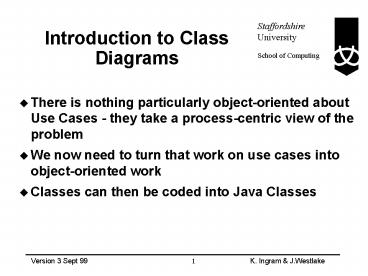Introduction to Class Diagrams PowerPoint PPT Presentation
1 / 18
Title: Introduction to Class Diagrams
1
Introduction to Class Diagrams
- There is nothing particularly object-oriented
about Use Cases - they take a process-centric
view of the problem - We now need to turn that work on use cases into
object-oriented work - Classes can then be coded into Java Classes
2
The OODI Methodology
- Analysis, Design, Implementation
Object Interaction/ statediagrams
3
What is a Class?
- A class is a thing or event of significance to
the system - A class can have attribute (data item)
definitions and operations (behaviour) - Individual Objects have the attribute values and
exhibit the behaviour which was defined in the
class to which they belong - This is fundamentally an object oriented premise
4
What is a Class Diagram?
- The Class Diagram describes the static structure
of the classes in a system and their associations
(relationships) - Initially, the Class Diagram should show only
classes and associations - Next, the attributes and operations can be added
rents
Video
Customer
?
5
Why use a Class Diagram?
- Depicts meaningful concepts and terms for the
problem - a sort of visual dictionary
- improve comprehension of the problem
- clarifies important information
- can lead to revision of the Use Case Model
- achieves a starting set of software classes
which can be refined as we progress through the
life cycle
6
Building a Class Diagram
- 1. identify the Classes and then draw a
preliminary diagram and then later. - 2. identify the preliminary associations and add
them to the diagram - 3. identify the attributes and add them to the
diagrams - 4. identify the operations and add them to the
diagram
7
1. How to identify the Classes?
- Various strategies exist! The objects are out
there Identification is not always easy! - 1.1. Work through a common concept categories
list - 1.2. Linguistic (Abbott) analysis of the
problem vocabulary and the Use Case scripts you
have created - 1.3. Create skeleton CRC cards during informal
brainstorming meetings - 1.4. Find and apply existing models(patterns)
from published sources
8
1.1 Common concept categories example
- Concept category Class
- physical object video
- specifications, designs video description
- transactions sales, payment
- roles customer
- organisations video store
- rules and policies LoanPolicy
9
1.2 Abbott Analysis
- Abbott, R., Communications of the ACM, Program
Design by Informal English Descriptions 1983 - make a list of the nouns or noun phrases in
descriptions of the problem area, requirements
document or the Use Case script - discuss these candidate classes and normally many
will be discarded - rather simplistic but very useful
10
1.3 CRC Cards(Class, Responsibility,
Collaboration)
- To enable a team to decide which are the
candidate classes after nouns analysis. - Stages
- 1. Write the name of each noun on a card.
- 2. Discuss the need for the class and discard a
class if necessary - identify each as a definite
class/ definite rubbish/ a doubtful class - 3. Write a short description of the purpose of
this class
11
2. Identify Associations
- Method
- 1. make a list of the verbs in descriptions of
the problem area, requirements document or the
Use Case script - 2. pair every class with every other class and
decide if there is a meaningful relationship - 3. On the CRC card identify Collaborators - the
other classes that this class send / receive
messages to / from
12
Associations (contd)
- Associations are shown as lines on the class
diagram - Multiplicity can be shown at each end of an
association by - any number 1 -
only 1 2.. - 2 or more 3..14 -
between 3 and 14 inclusive 3,5..7 - either 3
or between 5 and 7 inclusive
13
3. Identify Attributes
- Attributes in Class diagrams are just like
attributes in entity relationship models - Attribute type and default values can be shown on
the class diagram - Attributes are listed in the 2nd level of a class
box i.e after class name
Class Name
Attributes
Operations
14
4. Identify Operations
- Operations are functions that may be applied to
or by objects in a class - use verbs - On the CRC card identify Responsibilities - what
must this class do and what it knows - A method is the implementation of an operation
- Operations are listed in the lower third of the
class box. Each operation name may be followed
by optional details such as argument list and
result type
15
Further Reading
- You can refer to Select Enterprise v6 for further
information Help, Modelling,
Class Modelling, Techniques, 1.
Discovering Classes 2. Examining Use Cases
for Classes 3. Examining Events for Classes
16
Class Diagrams - Special Associations
- Generalisation - inheritance modelling
- Specialisation - inheritance modelling
- Aggregation
- These will appear as we progress with the design
- if there are obvious superclasses/subclasses
then great - include them but otherwise wait
until you modelled the dynamic behaviour - We will return to this subject to examine OO
principles such as reuse
17
Generalisation and Specialisation
- Inheritance is basically describes 'type-of'
relationships - Inheritance in shown in an class diagram by a
triangle see example - A discriminator is shown alongside the
generalisation symbol - see Class Diagrams How
To document - E.g. Clerk is type-of Employee
18
Aggregation
- Aggregation is used to represent 'part-of'
relationships between classes. - Aggregation is shown by the empty diamond in the
class hierarchy at one end of a relationship line - Cars are made up of steering wheels, engines,
transmissions etc. Each of these components may
be an object(class) in its own right. The
special association of a car to its component
parts is aggregation

